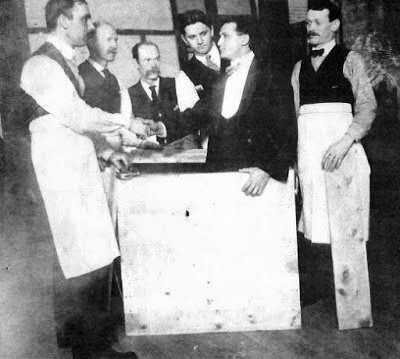The Red
Lion at No.34 Kilburn High Road is one
of our oldest pubs but is currently closed. It is not possible to trace it to
1444, the date displayed at the top of building.
The 17th century is
probably when it first started selling beer but the earliest recorded licence
dates from 1721. There are paintings of the old pub by local artist John
Rathbone in 1789 now in the British Museum, and one by his friend George Morland is in the Tate Gallery.
The pub was rebuilt several times.
The present ‘palatial building’ dates from 1890 when it replaced a two-storey
building, with a large bow front on either side of the main entrance and a
veranda at first floor level. The work took eight months to complete and the
Red Lion reopened that November. The following January, 300 people crowded in
to watch a special billiards match between the famous players Hughie McNeil and
William Spiller.
 |
| Two-storey building in 1889 (English Heritage) |
There have been many managers over
the years. From 1905 to 1914 it was Charles Edward Jenkins who had an interesting
background. Born in Cardiff around 1873, his wife Mary Jenkins was from Duffryn in South Wales. Beginning in
1896, Charles toured the music halls
with an astonishing hypnotism act under the stage name of ‘Professor Morris’. He
advertised in ERA, the trade paper for theatrical performers, that he could ‘en-trance’ a
man and bury him alive for up to 30 days! Jenkins was also a champion cycling racer, holder of the Welsh 100 mile
cycling record of 6 hours and 16 minutes in 1899. Clearly a man of many
talents, during his time in Kilburn he also became a very good competitive billiards
player.
In 1907
‘The Loyal Rose of Kilburn Lodge’ a friendly society of the Oddfellows, held their
annual concert at the Red Lion. The Kilburn Times reported that the audience
numbered around 200 ladies and gentlemen. There were songs with a piano
accompaniment and a comedy act. But the main attraction was Charlie Jenkins in
his role of Professor Morris, and his demonstration of hypnotism. He invited
onto the stage a young man he had cured of stammering, and other man he had
cured of a knee problem using electrical massage.
Then he asked for volunteers from
the audience who he quickly hypnotised. To demonstrate insensibility to pain,
he passed a needle and thread through their ears and lips with no signs of
blood. Then he got them to smoke a lighted candle which he told them was a
cigar. They also chewed the candles believing them to be bananas. Two of the
male volunteers provided amusing entertainment ‘believing’ they were a mother
and long-lost child.
The
following year Prof. Morris again performed at the Loyal Rose of Kilburn
concert. This time, in addition to hypnotising members of the audience, Morris
showed his electrical apparatus. He claimed that through hypnotism and
electrical massage he had cured over 250 patients of their rheumatism,
paralysis, gout and other complaints. This included a little boy with a curvature
of the spine who was able to walk without the use of his leg irons.
At a 1912
entertainment at the pub, Prof Morris climbed into a four feet square packing
case that had been specially made for the occasion by a local man, to be escape
proof. The top was screwed down and bound with rope before the box was put into
a canvas bag. This was secured at the top with chains and locks and hidden behind
a screen. Just over half an hour later, Prof. Morris appeared at the front of
the stage to great applause while the box and its covering were revealed as
intact.
 |
| Houdini entering the packing case |
We lose track of Jenkins at the
beginning of WWI when he may have joined the Army. The next time we can reliably
trace him is in 1939 when he had returned to Cardiff, and was running the Butcher’s Arms pub.
In April 1969 the Red Lion’s
manager 45-year old Patrick Sheridan, was walking the short distance to the
bank on the corner of Belsize
Road. He was
carrying his Easter takings totalling £1,700, (today worth about £28,000). Suddenly
he was bundled into the back seat of a Jaguar. The three men in the car robbed him
before throwing him out of the car three-quarters of a mile away. Although the
police investigated the theft, nobody was charged with the robbery.
 |
| Empty building in September 2019 (Dick Weindling) |
The Red Lion had become The Westbury by 2007 and in September 2012 it was a bar called Love and Liquor. Soul Store West, a dinner, cocktail bar and hotel with food by the Chicago Rib Shack, opened in March 2017 but closed suddenly that July. The building has been shut ever since. In September 2019 the large Star Pubs and Bars group who own the building applied for a new licence, so perhaps the Red Lion will reopen soon.



That is utterly gobsmacking! You might add that Idris Elba DJ'd there in one of its last incarnations.
ReplyDeleteThanks for the info abt Idris Elba, I did not know that.
ReplyDeleteVery glad you like the story of the pub's history.
Dick